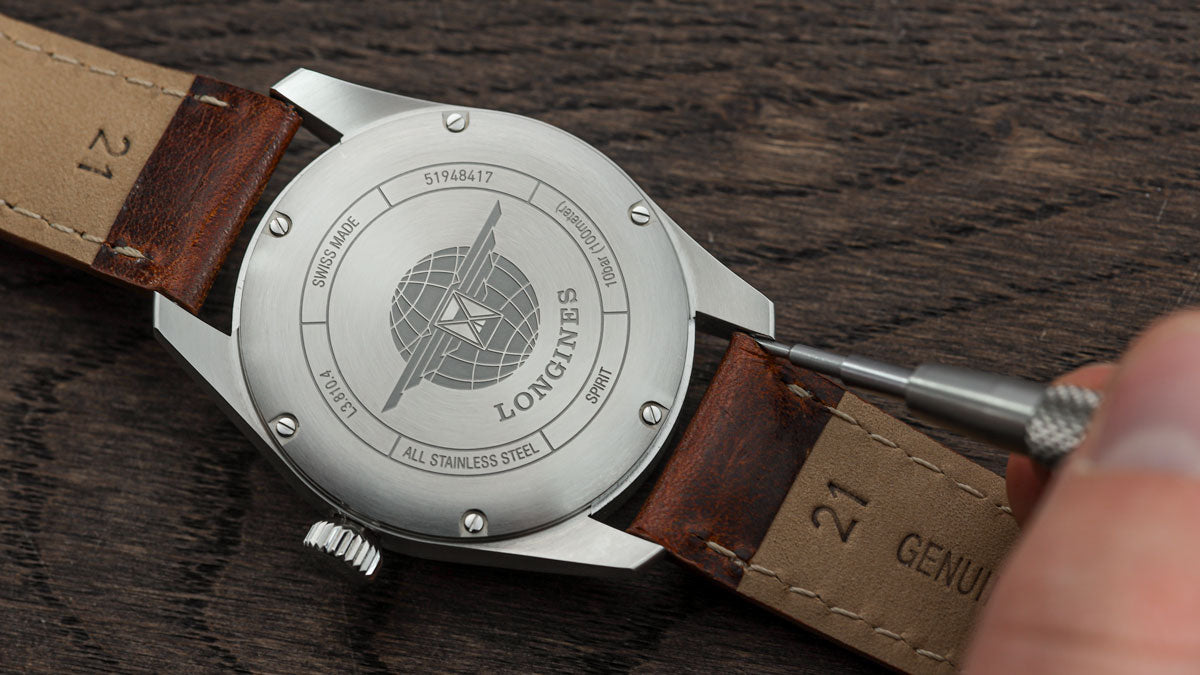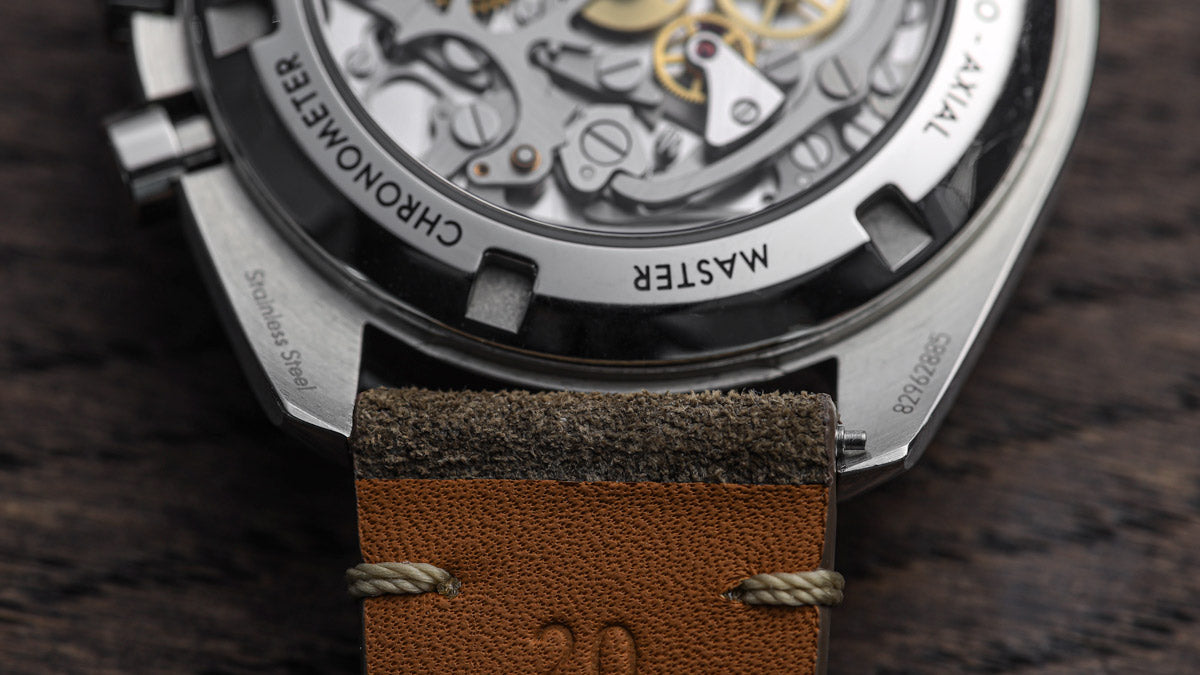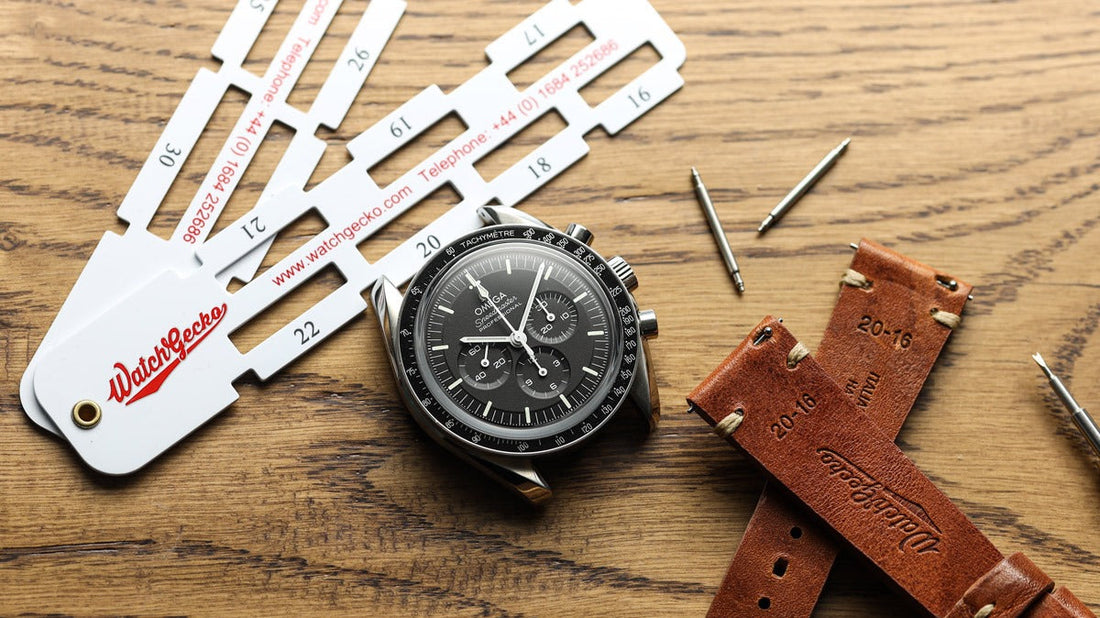The thought of changing a watch strap is a daunting prospect for many. Here we take you through the process step by step.
Before we start.
- Are you looking to change a metal watch strap? Click Here.
- Are you looking to install a nylon watch strap? Click Here.
- Are you looking for a general overview on changing and switching straps? Carry on Reading.
Table of contents
Step 1: Check what lug width your watch has
The lug width is the measurement between the two lugs and is measured in millimetres. Here is our guide on how to measure lug width.

If you plan to take your watch into the water, a rubber strap or metal bracelet will be most suitable. If not, your choice will widen to include our extensive range of leather and fabric straps.
Also, consider how far out from the case the lug holes are! Many people like the idea of a thickly padded leather strap, but sometimes if the lug holes are positioned very close to the case these may not fit or will cause scuffing to the leather where is hits the case between the lugs. If this is the case you’ll be better off with a lightly padded or unpadded strap. Otherwise though, the world is your oyster!
If you have an average or large wrist size, you should be fine with one of our standard length straps, but if you have petite wrists you can use this search to show only shorter length straps.
For more in depth advice, go to our article A Guide to Buying Watch Straps.
Step 2: Buy the correct tools for the job
You can find a great selection of watch tools in the accessories section of our website, including spring bar tools. As far as changing straps is concerned though, as long as you have a spring bar tool, you’ll be good to go!
What is a spring bar?
A spring bar is a round steel bar with spring-loaded telescopic ends that secure the watch strap to the watch case. When fitting any kind of replacement strap, these spring-loaded ends must be compressed. Then, once in place the spring-loaded ends decompress, filling the lug hole to give a secure fit.

Not sure which watch tools you need? Check out our article - Top 10 best watch tools every watch collector needs!
Ensure you have spring bars
If you’re the original owner of the watch and the strap is factory fitted, it’s usually best to use the spring bars that are already fitted. If not, you’ll need to order some. We stock three main types. Choose the one that best suits your needs. For most, this will be the standard type. Be sure to head over to our recent article Your Watch Strap Questions Answered to learn more about the different types of spring bars.

Preparation area
It’s a good idea to change straps sat at a table or other solid surface but use a rubber/foam matt, or other soft surface cover so that you reduce the chances of scratching your watch and also to help prevent it from moving around too much.
General tips
Tip 1: When removing any kind of strap, it’s always best to ensure that the spring bar is pushed out towards the rear of the watch so that any light scratches will not be seen when the watch is worn.
Tip 2: For additional protection against scratches, consider taping the lugs.
Now, Onto Removing the Strap...
How to Remove a Quick Release Strap.
Many modern straps and even bracelets come with quick-release straps. This makes it an absolute doddle to remove the strap without the need for tools. The spring bar is also retained so there is no chance of losing it, or it flying across the room.

How to Remove a Strap with Drilled Lugs.
Some watches have drilled lugs, which makes removing straps a lot easier. For these watches simply insert the rounded pin into the drilled hole making sure it’s in properly. Then gently push the tool to release the spring bar. You may have to wiggle the strap a little at the same time. Set the spring bar aside somewhere safe for later. When removing spring bars, always be careful not to lose the spring bar or worse, fling it into your eye.

If you watch has neither quick-release spring bars or drilled lugs, a little more skill is required. But don’t be put off. By following the simple steps below you’ll be up to speed in no time!
How to Remove a Bracelet.
On bracelets you’ll see that the end links of the bracelet (where it attaches to the watch head) will have cut-away slots allowing you to partially see the spring bar.


When you feel that the spring bar tool has located, gently pry the spring bar out by pulling to towards the centre of the watch until you hear/feel it release. Depending on the bracelet you may need to apply some pressure to the underside of the bracelet to get it to release.
Occasionally you may also encounter a stubborn bracelet and the spring bar may only partially release. If that’s the case, you will need to use the tool to release the spring bar on opposite side also.
How to Remove any other type of Strap.
Lay the watch face down on either a padded mat or soft cloth, ensuring there is a firm surface such as a table or bench beneath.
Then, using the spring bar tool, carefully position the v-shaped end so that it slots between the end of the strap and the inside of the lug. Applying light pressure against the spring bar, gently pry the spring bar out by pulling to towards the centre of the watch until you hear/feel it release.

Which way around does the strap go?
Leather, rubber or nylon straps
The buckle side of the strap is nearly always attached to the 12 o’clock side of the watch, and the tail end at the 6 o’clock side. (Notable exceptions include Grand Seiko and some Seiko straps).

Bracelets with a fold-over clasp
Ensure that the section of strap with the visible part of the clasp (often with the brands logo on) is fitted to the 12 o’clock side of the watch.

Bracelets with an unbranded, flush-fit butterfly clasp
It is not important which end is connected to which side of the watch. However, it is worth considering where the clasp section will sit when on wrist – this will vary between watches and bracelets.
Bracelets with a branded butterfly clasp
Ensure that you fit it so that when looking at the watch face on, the branding is orientated correctly.
How to Fit your New Replacement Strap?
Fit a new quick-release strap (leather, nylon, rubber, bracelet)
Our quick-release straps make fitting a cinch. Simply position the opposite end into the lug hole. Once secure, position the other side of the spring bar so that it roughly sits over the lug and then squeeze the bar inwards whilst positioning the strap until you feel/hear the spring bar snap into place. Give the strap a light tug to make sure its secure and you're good to go.
Fit a non-quick release strap
Tip: Remember where the lug hole position is so that it’s easier to accurately position the spring bar into place.
1. Place one end of the spring bar fully into one of the lug holes.

2. Once in place, position the other side of the spring bar so that it roughly sits over the lug.

3. Then, using the spring bar tool, compress the spring bar whilst lowering the end into place, aiming for the lug hole. Getting the second end of the spring bar into place is not always easy, so you may have to carefully move the strap around within the confines of the lug until you feel the spring bar locate and snap into place.
4. For extra finesse, refit the original branded buckle. In order to do this, you’ll need to make sure that the replacement strap has the same width on the buckle end as the original. To make it easier to find the right strap, we always state buckle end widths in our product listings.
5. Repeat this process for the other piece of the strap
6. Give the both end of the strap a light tug to make sure they are secure and you're good to go.
CAUTION: Bear in mind that even by closely following the instructions, as every watch enthusiast will tell you, changing a watch strap is not completely without risk and it’s not unusual with regular swap-outs to develop small scratches around the lugs. However, our instructions should at the very least help minimise this risk.
So there you have it! A full step-by-step guide on how to change your watch strap. Don’t forget to sign up to our newsletter to be the first to hear about new products and to receive exclusive discounts.





